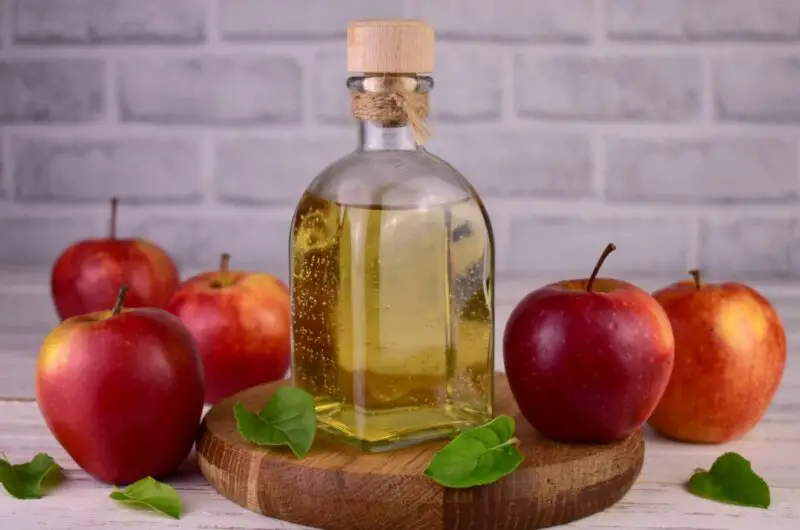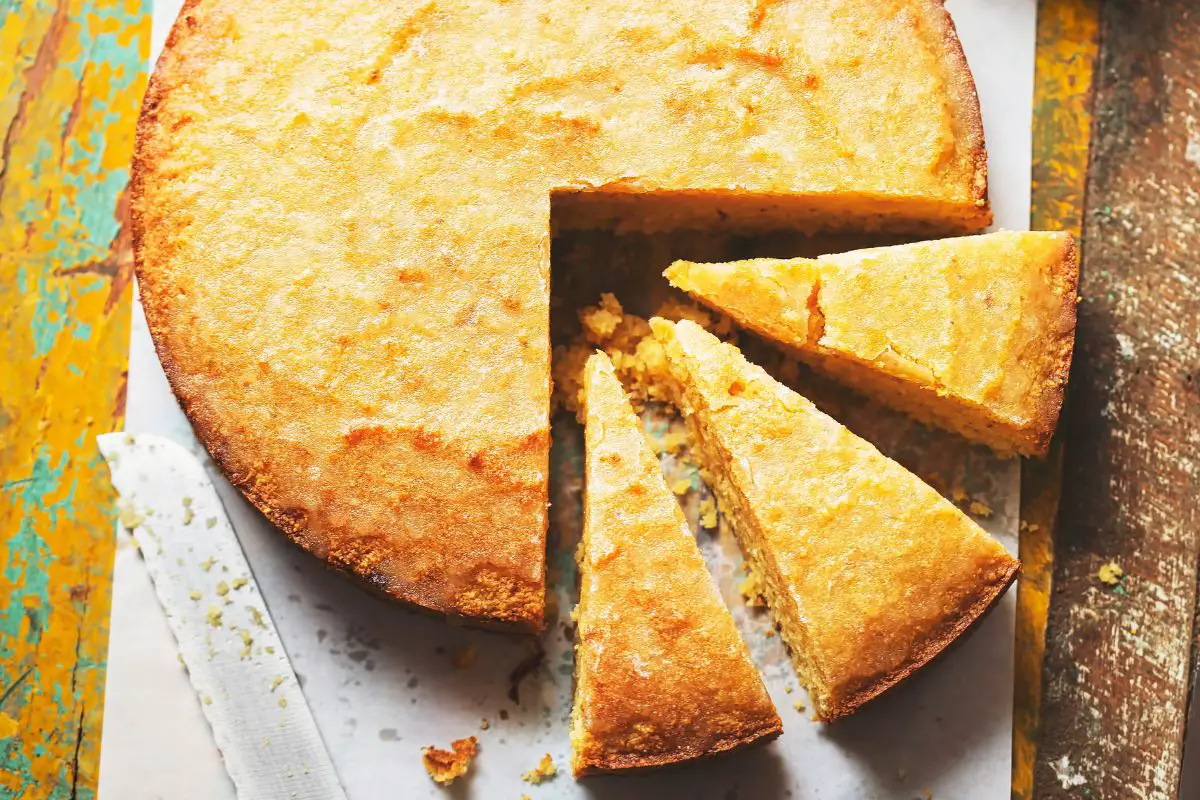Today, we’re going to pay homage to the versatility and rich flavors of homemade vinegar with these seven unique recipes by Martha Stewart.
From infused glazes to robust tonics and vibrant vinaigrettes, each recipe offers a way to make your own vinegar infusions.
These are perfect for dressing salads, marinating meats, or adding a burst of flavor to your favorite dishes.

These recipes are super simple, so even beginner chefs can follow along.
Let’s get started.
3 Flavored Vinegar Recipes From Martha Stewart
We’re going to start with 3 very different homemade vinegar recipes from Martha Stewart’s kitchen.
1. Sweet Sherry Vinegar Glaze
Martha Stewart’s sweet sherry vinegar glaze is an exquisite concoction that perfectly blends the rich, nutty flavor of sherry vinegar with the deep sweetness of light-brown sugar.
To begin, measure half a cup of light-brown sugar and an equal amount of sherry vinegar into a small saucepan. Whisk these ingredients together until well combined.
Place the saucepan over medium heat and bring the mixture to a boil, watching as the sugar dissolves and the mixture begins to bubble.
As the mixture boils, it will start to reduce, thickening into a glossy, syrup-like consistency. This reduction process typically takes about five minutes but may vary slightly depending on the heat level and the size of the pan. It’s crucial to monitor the glaze as it reduces to prevent it from burning, stirring occasionally to ensure even cooking.
Once reduced, remove the pan from the heat. Stir in a teaspoon of water, which will help adjust the glaze’s thickness and make it easier to drizzle. This addition also tempers the intensity of the flavor, ensuring that it enhances dishes without overpowering them.
This versatile glaze is ideal for a variety of culinary uses. Drizzle it over roasted meats to add a layer of flavor complexity or brush it on grilled vegetables for a touch of sweetness.
It also makes a lovely addition to cheese platters, pairing especially well with aged cheeses, or as a unique topping for ice cream and other desserts, providing a gourmet touch that elevates simple treats into elegant desserts.
2. Fire-Cider Tonic
Martha Stewart’s fire-cider tonic is a potent concoction designed to boost immunity and invigorate the senses.
This fiery mix combines raw, unfiltered apple cider vinegar with a robust blend of ingredients known for their health benefits.
Start by layering half a cup each of thinly sliced fresh ginger and peeled, diced horseradish in the bottom of a quart-sized jar.
Add smashed cloves from one head of garlic, a few sprigs of rosemary, two halved jalapeño or serrano chiles, a teaspoon of whole black peppercorns, and two cinnamon sticks.
Continue by adding half of a small onion, cut into large chunks, along with pieces of one lemon and half an orange.
Pour two cups of apple cider vinegar over the ingredients, ensuring everything is completely submerged, and add more vinegar if necessary.
Seal the jar tightly; if using a metal lid, place parchment paper underneath to prevent corrosion.
Store the jar in a cool, dark place, shaking it every few days. After three to six weeks, strain the contents through cheesecloth or a fine mesh sieve, discarding the solids.
Stir in one-third to one-half cup of raw, unfiltered honey, adjusting to taste.
The tonic can be stored in the refrigerator and used within a month, adding a zesty kick to beverages, dressings, or even consumed straight for its purported health benefits.
3. Champagne Vinegar
Turn leftover champagne into a delicately flavored vinegar with Martha Stewart’s simple fermentation technique.
To begin, pour any unused champagne into wide-mouthed jars. Leave these jars open to expose the champagne to air, which starts the natural fermentation process.
Over a few weeks, the champagne will transform into vinegar through the action of natural acetic acid bacteria present in the environment.
This homemade champagne vinegar is milder and slightly sweeter than other kinds of vinegar, making it an excellent choice for dressings and sauces where a gentle, fruity acidity is desired.
It pairs beautifully with seafood, can be used to deglaze pans for making light sauces, and is particularly good in vinaigrettes that benefit from its subtle flavor profile.
After the fermentation process is complete, cover the jars to stop further acidification and store the vinegar in a cool, dark place. It will keep for up to six months.
4 Stunning Sauces And Vinaigrettes From Martha Stewart
Now, let’s take a look at some super simple vinaigrette recipes that you can make in your own kitchen to spice up your salads.
1. Basic Vinaigrette
Martha Stewart’s basic vinaigrette is a classic dressing that can be added to any salad.
Begin by whisking together a quarter cup of white wine vinegar with a tablespoon of Dijon mustard, a quarter teaspoon of salt, and half a teaspoon of pepper in a small bowl. Adding a pinch of sugar balances the acidity and enhances the overall flavor profile of the vinaigrette.
Once these ingredients are well mixed, the next step is to slowly drizzle in three-quarters of a cup of extra-virgin olive oil while continuously whisking to create an emulsion.
The key to this vinaigrette is the emulsification process, where the oil and vinegar blend together to form a thick, creamy dressing rather than separating.
This basic vinaigrette is versatile and can be used as a dressing for green salads, as a marinade for chicken or fish, or drizzled over grilled vegetables. Its clean flavors complement a wide variety of dishes, making it a staple in any kitchen.
2. Honey-Balsamic Vinaigrette
This honey-balsamic vinaigrette offers a delightful blend of sweetness and tartness, making it a favorite for dressing salads or drizzling over roasted vegetables.
Start by whisking together two tablespoons of balsamic vinegar and one tablespoon of honey in a small bowl until the honey dissolves.
Add a teaspoon of Dijon mustard to the mix, which helps to stabilize the emulsion and adds a mild spicy flavor that complements the sweetness of the honey.
Gradually pour in a quarter cup of extra-virgin olive oil, whisking continuously until the vinaigrette is smooth and thickened. The balsamic vinegar provides a rich, slightly sweet flavor that is enhanced by the honey, while the olive oil adds a smooth texture and mellows the acidity.
Season the vinaigrette with coarse salt and ground pepper to taste, adjusting the seasoning to balance the sweetness and acidity.
This vinaigrette is especially good on salads that feature ingredients like goat cheese, nuts, or fruits, as it pairs beautifully with their flavors.
3. Vinegar Garlic Dipping Sauce
Martha Stewart’s vinegar garlic dipping sauce is a robust and flavorful accompaniment to a variety of dishes. Combine two tablespoons of minced garlic with half a cup of distilled white vinegar and a quarter cup of soy sauce in a small bowl.
The garlic provides a strong, pungent flavor that is mellowed by the tanginess of the vinegar and the deep, umami taste of the soy sauce.
Whisk these ingredients together until well blended.
This sauce is versatile and can be used as a dipping sauce for dumplings, spring rolls, or fried foods, adding a sharp and savory note that enhances the flavors of the main dish.
It can also be used as a marinade for meats, lending a complex flavor profile that penetrates deeply into the food.
Store the sauce in an airtight container in the refrigerator for up to three days. Before serving, allow it to come to room temperature and whisk again to ensure all the flavors are evenly distributed. Pour into individual dipping bowls for serving.
4. Mustard And Herb Vinaigrette
Our final recipe – this mustard and herb vinaigrette – is a vibrant and aromatic dressing showcasing garden herbs’ fresh flavors.
Start by combining one teaspoon of Dijon mustard and half a teaspoon of minced garlic with two tablespoons of white wine vinegar in a small bowl. This mixture forms the acidic base of the vinaigrette.
Gradually whisk in a quarter cup of extra-virgin olive oil to create a smooth, emulsified dressing. The slow addition of oil is crucial for achieving the right consistency.
Once the base is emulsified, stir in a quarter cup of finely chopped mixed herbs, such as tarragon, chives, and cilantro.
These herbs bring a burst of freshness and color to the vinaigrette, each offering unique flavors that complement the sharpness of the mustard and the tanginess of the vinegar.
Season the dressing with salt and pepper to taste, adjusting the seasoning to highlight the herbal notes.
This vinaigrette is particularly effective on spring and summer salads, drizzled over steamed vegetables, or used as a marinade for light proteins like chicken or fish. Its fresh, herbaceous qualities make it a tasty addition to any meal that calls for a touch of zest.
Final Thoughts
Martha Stewart’s collection of flavored vinegar recipes and vinaigrettes is a must-try. They take a simple ingredient and turn it into exceptional sauces and dressings that transform everyday meals.
Whether you’re looking to add a tangy kick to your salads with a basic vinaigrette or enhance your health with a sip of fire-cider tonic, these concoctions are versatile, flavorful, and oh-so-easy to recreate at home.
7 Flavored Vinegar Recipes By Martha Stewart (Including Delicious Vinaigrettes)
Course: Martha Stewart4
servings30
minutes40
minutes300
kcalIngredients
Directions
- Choose a vinegar recipe
- Gather your ingredients
- Make your vinegar
- Enjoy with your meal.
Recipe Video
https://www.youtube.com/watch?v=qmsOnZ7XZRcVideo can’t be loaded because JavaScript is disabled: Basic Vinaigrette- Martha Stewart (https://www.youtube.com/watch?v=qmsOnZ7XZRc)- 16 Martha Stewart Baking Recipes You Have To Try - May 29, 2024
- 19 Of The Best Martha Stewart Cake Recipes Ever - May 28, 2024
- How To Make A Tasty Ina Garten Red Velvet Cake At Home - May 24, 2024











